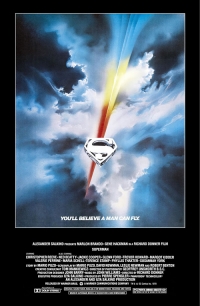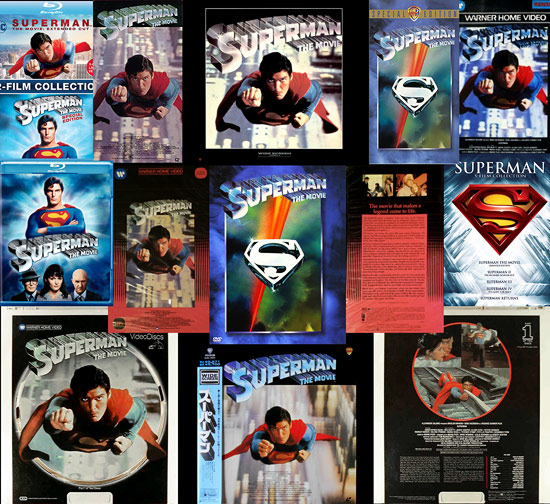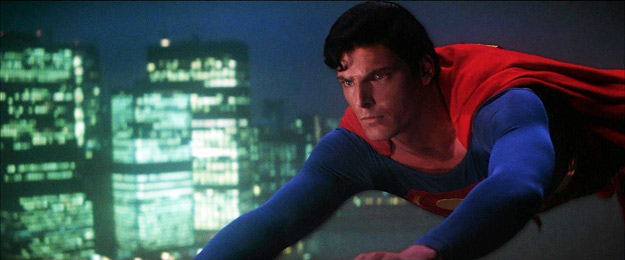
Coate: Between the original theatrical release, television broadcasts and the numerous home-video releases of Superman, which cut/version do you believe is the best?
Bowers: Superman editor Stuart Baird is one of my greatest filmmaking heroes. Assembling the ultimate theatrical cut of the first movie, with over two million feet of film at his fingertips, was likely first viewed as an unsurmountable task. What I experienced in the theater will remain my favorite cut — beautifully paced and balanced, retaining many of Richard Donner’s continuous and perfectly choreographed takes (such as Clark asking Lois out to dinner as they walk through the Daily Planet offices, followed by Lois going into the ladies room and Clark pressing the down button at the elevator), and showcasing the best of the best from the lead actors and supporting cast, specials effects wizards, and seasoned crew. I see the 188-minute extended release — first shown on ABC-TV in 1982 — as a bonus gift after a birthday celebration; a marvelous surprise and curious insight into the level of energy and talent poured into the long and challenging production.
Matessino: I think that the original theatrical release — with its original sound mix only — is nearly perfect. The extended TV cut is interesting because we get to see what else was shot and it serves its own purpose, but I think all the right editorial decisions were made in creating the theatrical cut. The one piece of added footage I wish they’d kept is the one that shows Superman’s attempt to catch the eastbound missile head on, only to establish that its avoidance system prevents him from doing so. The movie establishes that Metropolis is basically New York with a name change, and therefore the geography is unclear when Superman leaves Metropolis and ends up behind the eastbound missile. They may have cut that material because the visual effect was unsatisfactory, but it also unfortunately necessitated the abrupt cutting of the music score there.
Scivally: I’m always a fan of sticking to the original presentation, so I prefer the original theatrical cut. The same goes for Superman II — despite the much-heralded Donner Cut, I still feel the original Donner/Lester hybrid is superior.
Tye: The [TV] cut is great but I like the one that I saw in the theaters.
Coate: Superman was made in a mixture of styles and tone, particularly with respect to the direction, acting and cinematography. Is this an asset or detriment to the overall effectiveness of the movie?
Bowers: There’s something for everyone in Superman: The Movie. I view the mixture of styles and tone as an absolute asset to the movie’s appeal. I’ve always viewed this movie as a trilogy — three distinct chapters that tell a complete origin story, from Kal-El’s journey from a strange and magical planet, to his arrival to Earth in an Andrew Wyeth-esque environment that firmly establishes his “human” roots, to his reveal to the world to fight for Truth, Justice, and the American Way...and discovery of the love of his life. Today I can’t imagine the movie not having these three “flavors”. It works, it just does.
Matessino: It works for me because that’s the character’s experience. We’re introduced to his place of origin, a truly alien world and then his life experience, which is rural Americana and then the world’s biggest, most bustling city. This is contrasted by the villain Lex Luthor, who is arrogant and feels in control of that world. The changes in tone and photographic approach reflect this. Life changes its look and its tone, after all. It made the movie feel more real and relatable.
Scivally: Despite the reservations I had on first seeing it, I can now appreciate the way the movie switches tones from the Krypton scenes to the Smallville scenes to the Metropolis scenes. If they had kept up the solemnity of the Krypton scenes throughout, the movie might have ended up being overly dark, as I feel today’s modern superhero movies are. And especially with Superman, who is a character who represents light and goodness and the best qualities we have inside us, audiences should be able to have some fun in the theater. Batman — that’s a different story.
Coate: What did Donner’s Superman do well that previous incarnations, sequels, imitations and reboots have not?
Bowers: Superman: The Movie delivers in spades the best of what the cinema is meant to offer moviegoers: pure magic, heart, optimism, wonder, adventure, love, loss, yearning, escapism, and bright colors. We get to fly with Superman! The Daily Planet newspaper headline “CAPED WONDER STUNS CITY” reflected how the public, both inside the movie and inside the movie theater, felt about this “friend from another star”… stunned. We totally believed that this “guy that flies… with bright red boots” was the real deal who recognized his calling and wished to make the planet a safer place.
Burns: Entertain and satisfy. Even with the goofiness of the Metropolis section. Even with the contrivance of turning back time, it was bold. And Christopher Reeve… you can’t disassociate the film from that performance.
Matessino: For me, what Donner’s film did is reach beyond non-comic book readers to all potential viewers, young and old, and to everyone who enjoyed going to the movies. It didn’t require you to have any experience with the character prior to that. The other thing it did, rather boldly, was set it in the real world of the late 1970s. It was not really stylized in any way. What they shot on the streets of New York felt like the exact same city as Taxi Driver. The movie’s famous tagline was “You’ll believe a man can fly” and it delivered that not only through its groundbreaking effects but by placing Superman in a world that was familiar and that felt very real. Some of the latter day entries in the genre do this in their own way, but for me nothing comes close to the sense of realism that the first Superman achieved. Think about how hard it is to pull off a character in a costume like that and have an audience accept it. You can either make the world completely fantastic and stylized so that he doesn’t stand out… or you can do the tough work of figuring out how to get the script, the cast, the look and the tone exactly right so that this character can speak to a pimp before he stops a falling helicopter, and then crowds in the street applaud the arrival of a true hero.
Scivally: As I said earlier, Donner’s Superman was the first superhero movie to be made like a serious Hollywood epic. Prior to the late 1970s, if you set out to make a superhero film, it would be considered a “B” movie — at best — and be done with a small budget, like Warner Bros.’ previous Doc Savage film. Superman was a game changer. After Superman, studios realized that if they took these films seriously, so would audiences, and the box-office rewards could be astronomical. As a result, by the 1990s, there had been a flip-flop in film budgeting. Movies that — in the early 70s — would have been considered “B” films were now “A” films with “A” budgets, and films that would have been considered “A” movies were now being done as “B” films with smaller budgets, if at all. In terms of other Superman films, what Donner — and Tom Mankiewicz — got right is that Superman is, at heart, an innocent with super powers. Superman Returns and Man of Steel, in my estimation, were misfires, trying too hard to give a dark inner turmoil to the character. He ain’t Batman, but since The Dark Knight was, for a while, the second highest-grossing film in history, moviemakers keep trying to turn him into a conflicted Batman-type character.
Tye: He made us believe not just that a man could fly, which was the marketing promise, but that Superman still soared.
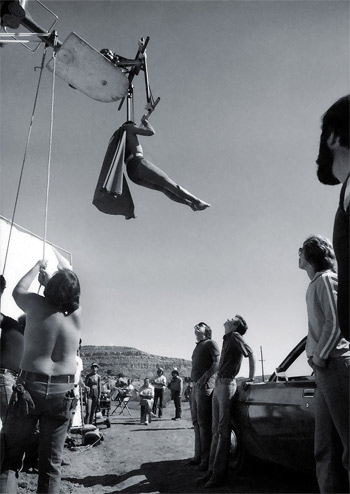
Coate: Where does Superman rank among director Richard Donner’s body of work?
Bowers: Superman: The Movie is most certainly Richard Donner’s greatest cinematic achievement. It was his “baby,” a project he embraced because of his belief of, and devotion and love for, Jerry Siegel and Joe Shuster’s character. The opportunity must have nearly knocked Richard off his toilet seat when Alexander Salkind offered him the job in 1976! This movie is still a very emotional topic for him today.
Matessino: Donner would be lauded for the film even if he had not directed any others. But certainly it’s one of several for which he will be remembered along with The Omen, The Goonies and Lethal Weapon. He was obviously the perfect director for Superman and I think its success played a role in the longevity of the character.
Scivally: When I think of Richard Donner, three films immediately come to mind: The Omen, Superman and Lethal Weapon. For me, Superman is his best film.
Tye: It is, I think, his best. I was with him last year in Los Angeles, in a program I moderated, and I can’t imagine that he would disagree. He loved Superman from boyhood, and gave us a hero worthy of the one he worshipped.
Coate: What is the legacy of Superman: The Movie?
Bowers: Superman: The Movie is a monumental achievement in cinema thanks to its filmmakers, producer Ilya Salkind — who envisioned Superman on the silver screen — and actors who gave it its heart and soul, who made it succeed, and made everyone Believe A Man Could Fly. Richard Donner wrote in a memo to the cast and crew in early 1978, “I love you all, everything is going Super. The Magic is still ours. Let’s keep it that way.” Superman: The Movie radiated magic in 1978 and continues to captivate the world 40 years later. This December, surely multitudes of fans will be watching Superman: The Movie — via streaming, DVD, Blu-ray or the new 4K UHD — with the same hope, optimism, and innocence they felt the first time they watched in awe as Christopher Reeve soared out of the Fortress of Solitude and into the world.
I would like to thank you, Michael, for including me in his special anniversary article, and Brian McKernan and Bill Williams for writing assistance and inspiration for many years. I Will Always Believe A Man Can Fly.
Burns: I don’t know if you’d have the Tim Burton Batman or Chris Nolan Batman or Iron Man or this incredible legacy of film franchises if Superman had not been successful. It was the first.
Matessino: Superman is the ultimate immigrant story. When Superman flies over the Earth at the end of the picture, with that grand score playing, it’s the character now claiming this place as his home. He has become fully part of a place that was originally foreign to him and has figured out his place in it. Of course it has overtones of the stories of Moses and Jesus and so it is overflowing with mythic resonance. All of that comes out in the 1978 film without it feeling heavy handed. It came out at the perfect time because prior to that things were campier and in later decades we moved toward making things darker and more complex. In the 1970s movies felt very real and yet it was acceptable at the time to put the tongue into the cheek here and there and have a little fun with it. But underneath it all is a basic story that we can all relate to that has to do with wondering about our origins, looking at our formative experiences, and figuring out a way to let the selfless, heroic part of ourselves express itself in our lives. If you had to pick one incarnation of Superman where all of this is codified definitively, it’s Superman: The Movie.
Scivally: As a character, Superman is a symbol of what is best about human character; he really does represent truth and justice, and at one time — when the phrase had only positive connotations — the American Way. Superman — the movie — was a major game-changer in Hollywood. And I do believe Ilya Salkind, its producer, should get credit for seeing that a comic book character, treated with respect, can connect with a mass audience. Had he not had that vision and pursued it, we wouldn’t have any of the superhero movies we have today; they’d still be “TV material.”
Coate: Thank you — Jim, Kevin, Mike, Bruce, and Larry — for sharing your thoughts about Superman: The Movie on the occasion of its 40th anniversary.
--END--
IMAGES
Selected images copyright/courtesy Jim Bowers, Dovemead Limited, Film Export A.G., International Film Production, Warner Bros. Pictures, Warner Home Video. Home-video collage by Cliff Stephenson.
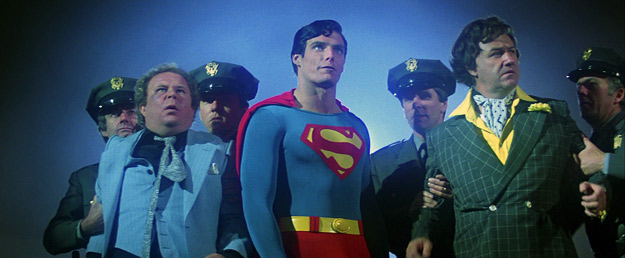
SOURCES/REFERENCES
The primary references for this project were regional newspaper coverage and trade reports published in Billboard, Boxoffice, The Hollywood Reporter and Variety. All figures and data included in this article pertain to the United States and Canada except where stated otherwise.
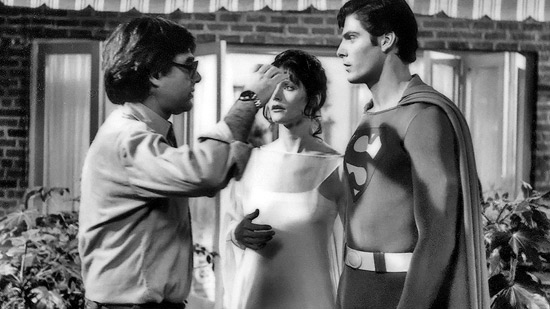
SPECIAL THANKS
Jim Bowers, Kevin Burns, John Hazelton, Bill Kretzel, Mike Matessino, Bruce Scivally, Cliff Stephenson, Larry Tye, Sean Weitzel, and a very special thank-you to all of the librarians who helped with the research for this project.
IN MEMORIAM
- Geoffrey Unsworth (Director of Photography), 1914-1978
- Les Bowie (Creative Supervisor of Mattes & Composites), 1913-1979
- John Barry (Production Designer), 1935-1979
- John Stuart (“10th Elder”), 1998-1979
- Denys Coop (Creative Director of Process Photography), 1920-1981
- Antony Scott (“5th Reporter”), 1933-1983
- Robert Henderson (“2nd Editor”), 1904-1985
- Michael Gover (“6th Elder”), 1913-1987
- Trevor Howard (“1st Elder”), 1913-1988
- Harry Andrews (“2nd Elder”), 1911-1989
- Norman Warwick (“Superchief Driver”), 1924-1989
- Gordon K. McCallum (Re-Recording Mixer), 1919-1989
- Roy Charman (Sound Mixer), 1930-1990
- Lee Quigley (“Baby Kal-El”), 1976-1991
- Joe Shuster (Superman Co-Creator), 1914-1992
- Bob Peak (Promotional Material Illustrator), 1927-1992
- Derek Meddings (Model Effects Director & Creator), 1931-1995
- Jerry Siegel (Superman Co-Creator), 1914-1996
- Alexander Salkind (Presenter), 1921-1997
- Mario Puzo (Story), 1920-1999
- Billy J. Mitchell (“1st Editor”), 1942-1999
- Rex Everhardt (“Desk Sergeant”), 1920-2000
- David Neal (“7th Elder”), 1932-2000
- Roy Field (Creative Supervisor of Optical Visual Effects), 1932-2002
- David Newman (Screenwriter), 1937-2003
- Alan Tilvern (“2nd Controller”), 1918-2003
- Robert MacLeod (“General”), 1915-2004
- Marlon Brando (“Jor-El”), 1924-2004
- Christopher Reeve (“Superman”/“Clark Kent”), 1952-2004
- Maria Schell (Vond-Ah), 1926-2005
- John Hollis (“4th Elder”), 1927-2005
- George Harris II (“Officer Mooney”), 1921-2005
- Phil Brown (“State Senator”), 1916-2006
- Roy Stevens (“Warden”), 19??-2006
- Glenn Ford (“Pa Kent”), 1916-2006
- Tom Mankiewicz (Creative Consultant), 1942-2010
- Susannah York (“Lara”), 1939-2011
- Jackie Cooper (“Perry White”), 1922-2011
- Phyllis Thaxter (“Ma Kent”), 1919-2012
- Larry Hagman (“Major”), 1931-2012
- Stuart Freeborn (Creative Supervisor of Makeup & Special Visuals), 1914-2013
- Vas Anderson (“3rd Elder”), 1933-2015
- Margot Kidder (“Lois Lane”), 1948-2018
- Yvonne Blake (Costume Designer), 1940-2018
-Michael Coate
Michael Coate can be reached via e-mail through this link. (You can also follow Michael on social media at these links: Twitter and Facebook)


